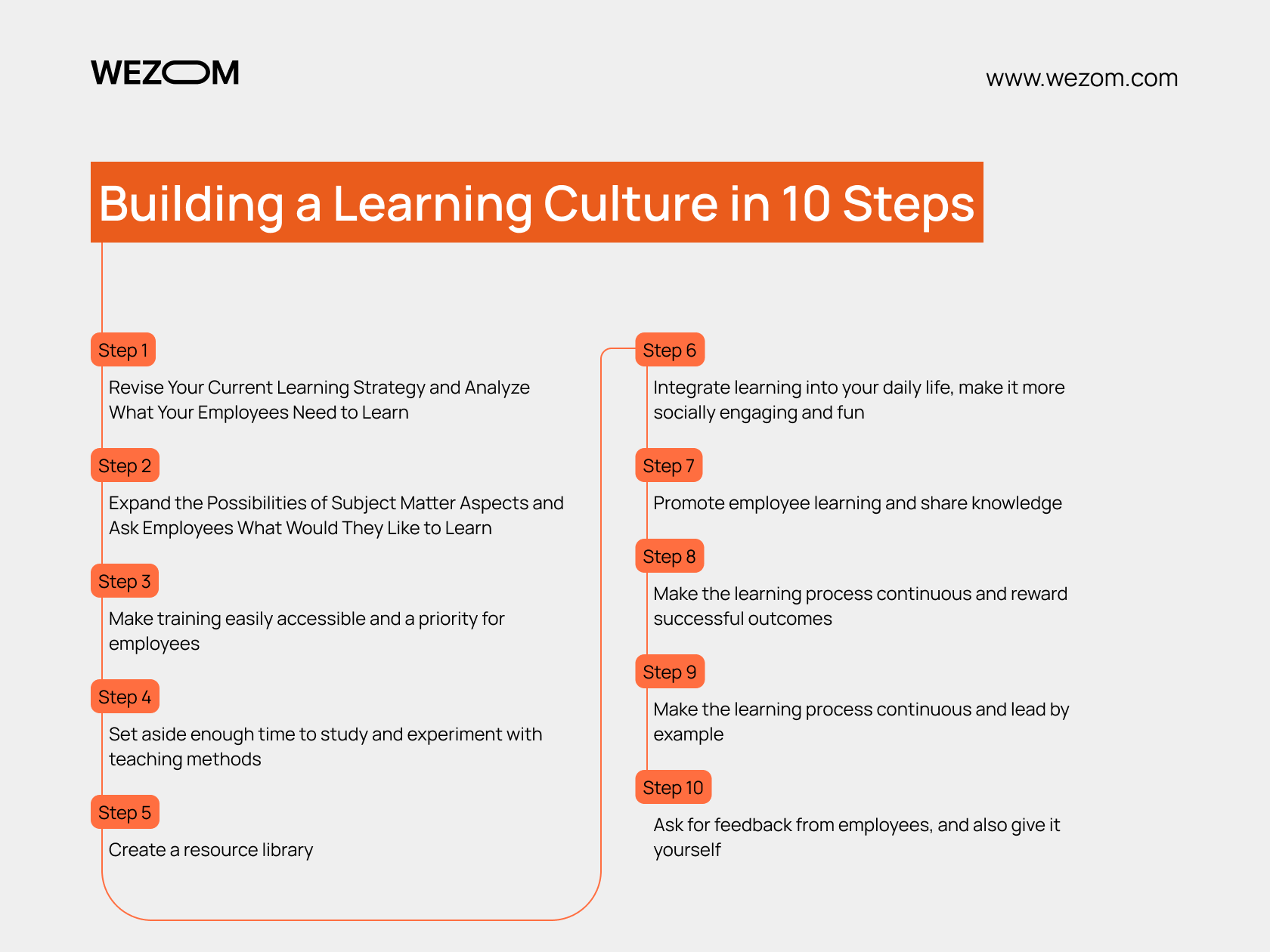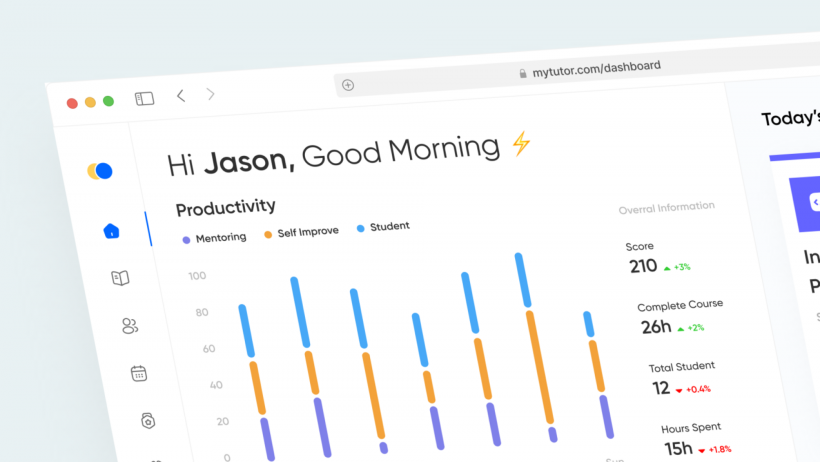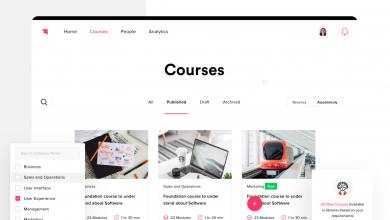Progress and development are two irreplaceable parts of modern businesses’ path of growth. You can stop for a short period of time, and your competitors will easily beat you. And this is the thing you definitely need to avoid.
In 2023, PwC has initiated a survey among more than 4400 businesses and business owners to know what are the main challenges in their work.According to the survey, 80% of the interviewed people named the need for new skills their main problem. What does it tell us, exactly?
It signifies us that the creation of a corporate learning culture becimes a reallly pronounced priority for modern businesses. Especially if we are talking about large companies with large a large staff. Let’s have a look at it.
What Is Learning Culture in an Organization?
Let’s discuss the main terms to avoid confusion:
- Corporate culture is a set of values, practices, and mechanisms that define the way the work is done in an organization, as well as how the employees are interconnected. It reflects the mission, vision, goal, and the company’s strategy, as well as it’s story, traditions, and symbols.
- The corporate educational culture is a component of the whole corporate culture which presents the set of beliefs, values, and practices that support education and growth of employees.
For the better understanding of how the corporate culture in organizations is implemented, you can check out our case Transport Learning Management System. In this study, the whole process is examined in detail.
Why Is Learning Culture Important?
Here, it’s worth mentioning another survey, which says among employees of different companies working in various business segments, it was found that 84% of employees in the most effective organizations constantly receive the training and new knowledge they need. And only 16% do not receive it.
Also, 94% of employees said that the building a culture of learning, as well as a company investing in employees’ growth are among the reasons why hey decided to stay on the recent job position for a longer period of time.

But let's be more specific: what actual benefits does the properly built learning culture in the workplace?
- Productivity increase. New knowledge and skills directly affect the efficiency and productivity of each employee. An extensive learning culture helps you achieve your organization's business goals faster and more efficiently.
- Attracting and retaining talented employees. Modern specialists are looking for not just an opportunity to work and earn. They want to develop and move forward. Therefore, the process of forming a culture of learning in the company is really important for them.
- The growth of employee engagement. According to the survey conducted by the Josh Bersin Company, employees who receive on-the-job training programs are 47% less stressed, 39% more likely to feel productive, and 23% more likely to take responsibility. Plus, every fifth employee considers himself more confident and happy.
- The increase in customer satisfaction. It is evident that a well-educated, motivated specialist who is satisfied with his or her job can handle the asks way more efficiently. And thus, the company’s clients, with whom he or she is working, will be satisfied with the collaboration.
- Development of future leaders. Continuous learning really contributes to the comprehensive development of employees and allows you to “nurture” real leaders in your niche, increase their productivity and professionalism.
In addition, a culture of learning promotes innovation in the company's activities and its comprehensive development. According to a Deloitte report, about 92% of organizations with an effective learning culture are more committed to innovation.
Building a Learning Culture in 10 Steps
So, if you are seriously thinking about developing and implementing a corporate learning culture, be prepared to devote a lot of attention and effort to this issue. Because the work to be done is really complex, and conditionally it can be divided into 10 main steps.

Step 1. Revise Your Current Learning Strategy and Analyze What Your Employees Need to Learn
It is likely that right now you already have a certain learning culture – formal or informal. Therefore, in order to introduce a new one, you will have to destroy the old one, and not try to impose one on the other.
It's really best to start from scratch. And the first thing you have to do is to seriously and comprehensively consider in what direction your employees should develop and move, what they should learn, what useful skills and knowledge they should acquire. Without a goal, there will be no result. And learning for the sake of learning is definitely a failed strategy.
Step 2. Expand the Possibilities of Subject Matter Aspects and Ask Employees What Would They Like to Learn
We live in an era when a huge amount of information is freely available - take it and use it. But finding and isolating really relevant, valuable and relevant information in this endless stream can be very difficult. Engage experts, draw on your own experience and, of course, interact with staff.
You need to consider not only what you, as a business owner, want to see in your employees, but also what they themselves want to learn and what they see as the main value. The ability to listen to others is a very important part of the formation of a culture of learning in a modern company.
Step 3. Make training easily accessible and a priority for employees
For an effective learning process, you need a well-designed, convenient and intuitive LMS that every employee can work with. We have experience in creating complex LMS from scratch and we talked about it in our case of Developing a Custom LMS for Wezom Academy.
Perform effective onboarding of new hires through LMS, workshops and mentoring. Encourage employees to continue learning throughout their career in the organization. This way you will make the learning process an integral part of the life of the company.
Step 4. Set aside enough time to study and experiment with teaching methods
The organization should support and recommend the allocation of time for training. Some businesses set a rule: at least 2 hours a week for education. Informing all employees of the opportunity to set aside time to brush up on skills contributes to a culture of learning. Remember that your staff must have time and energy to gain new knowledge, otherwise everything is wasted.
Also, do not forget about the possibility of introducing different methods and formats of training. Try coaching, group and face-to-face classes, online courses through LMS. Or combine them into a blended learning model for greater efficiency.
Step 5. Create a resource library
With the help of a learning management system, you can create and store a collection of resources that will be available to your employees at any time. This central repository may contain a variety of documents that may be useful to students, but are not required to study.
Your employees will be able to easily access these resources directly in the LMS, view various documents, videos or slide shows on a topic of interest to them at any time convenient for them.
Step 6. Integrate learning into your daily life, make it more socially engaging and fun
Integration into everyday life, socialization and eLearning gamification make the process of acquiring new knowledge and skills more exciting, intense and even in some sense reckless, as a spirit of competition is formed between students.
Use different learning formats, create forums and other communication channels for students, let them exchange ideas and useful resources to encourage and support each other. Plus, you can introduce gamification elements such as rewards, leaderboards, and employee motivation – this is a great incentive to study even harder.
Step 7. Promote employee learning and share knowledge
First, you must notify employees in advance of the decision to implement a training system. Secondly, try to objectively and clearly explain why this is being done and that everyone will benefit from it. And third, share your own knowledge and experience to highlight how important professional development is to career advancement opportunities.
Step 8. Make the learning process continuous and reward successful outcomes
Use an LMS so that employees have access to information and knowledge bases at any time when they need it. If a company has multiple programs, courses, and learning channels, it can be helpful to let employees choose what they want to learn. And even better if they have tools for curriculum planning.
Student motivation is essential to a successful learning process. As we said above, the reward system can work great and encourage employees to study harder. Even a personal message via Email or Slack that a person has done a good job can be a powerful incentive. Remember this!
Step 9. Make the learning process continuous and lead by example
There is a common mistake: a company introduces a corporate culture of learning, organizes one or two courses, and then for whole months this initiative goes by the wayside. A culture of learning is not a one-time practice. Training should be continuous, it is very important to constantly work on creating new training programs and improving existing ones. Otherwise it just doesn't make sense.
Remember also that culture in business comes from the top down. If management emphasizes the importance of learning by example and shows results, it motivates other employees to become better, develop and, of course, earn more. And vice versa, if the management “stands still”, but requires employees to devote all their free time to studying and work almost to the point of wear and tear, nothing good will come of it.
Step 10. Ask for feedback from employees, and also give it yourself
Interact with employees during their learning process, give them feedback, take an interest in their successes, and most importantly, ask how satisfied they are with the training and what they would like to change. For greater objectivity, you can conduct an anonymous survey.
It is also important to understand here that it is almost impossible to implement a 100% effective corporate learning culture the first time. In any case, it will need to be optimized, refined and improved. And without student feedback and following new trends in your niche, this is simply impossible. Analyze, measure results and adapt the learning process!
Build a Learning Culture That's Tailored to Your Organization: Our Experience
Finally, let’s talk about something really important: despite the large number of ready-made LMS for onboarding and training, the vast majority of them are not customizable enough and, therefore, are not suitable for large enterprises since they are not able to take into account the specifics of their workflows.
So, what should you do in this case? The answer is simple: develop a custom LMS from scratch. This is a rather complex process that requires not only deep expertise in the business niche in which the company operates but also awareness of the specifics of such solutions in general.
By the way, we already have experience working on such solutions – we have developed WEZOM INFO, a personal cabinet for onboarding, staff education, and recruitment automation for the WEZOM group of companies.
.png)
The need for this a solution arose for a reason: we needed an automated solution that would include feature such as onboarding, employee training, informing employees about what is happening in the company, as well as optimizing work processes within the HR department. At the same time, solutions that existed on the market did not meet our needs in terms of functionality and level of cybersecurity. Actually, this prompted us to custom development.
After discussing the requirements for future software, we identified the following global tasks:
- creation of a corporate HR platform for automating manual work processes, onboarding new employees and improving the skills of existing ones, as well as optimizing communication within the company;
- development of a web application with a personal account for employees;
- creating a model for onboarding, training, and testing new employees within the company;
- platform integration with accounting tools, project management, time tracking, etc.
Let's take a closer look at how we implemented our plans.
- Eliminating problems with the adaptation of new employees. When new employees register an account, they get to the corporate landing page and also gain access to the knowledge base and onboarding tools. It also presents the structure of the company's departments in the form of a schematic tree.
- Online employee training. Using this platform, new employees can seamlessly move from onboarding to training and professional development. Also, they can regularly pass tests here to assess their level of knowledge and competence.
- Automation of HR tasks. Instead of coordinating vacation requests by email or manually, our solution automated this procedure, allowing it to be completed through employees’ personal accounts.
- Working time tracking and internal communication between employees. Employees can get instant access to up-to-date data on their working hours to evaluate their productivity. This data is also visible to department heads so that they can more correctly distribute workloads and minimize downtime. Finally, here’s the WEZOM structure tree, where managers can find contacts for any specialist.
As a result of the implementation of our custom LMS, we were able to achieve a fundamentally new level of automation for HR tasks, boost employee productivity (by 37 percent on average), reduce employee turnover (the average time an employee works in our company increased by almost a quarter), and also provide end-to-end monitoring of working hours (which allowed us to reduce the amount of unplanned work by almost half).
The solution is currently available as an MVP, and we are actively working on new features for the personal account, such as online training and testing, as well as Performance Review tools.
If you are interested in developing a custom LMS for your business, feel free to contact us. We will carefully analyze the specifics of your company, assess the gaps in its regular workflows, and create a product that will help you achieve top productivity at all levels.


